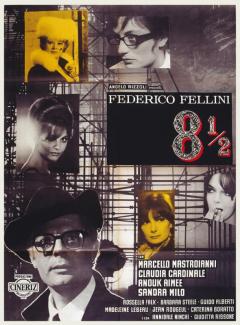Crew
Director: Federico Fellini
Story: Federico Fellini, Ennio Flaiano (ideato da Federico Fellini)
Screenplay: Federico Fellini, Tullio Pinelli, Ennio Flaiano, Brunello Rondi
Cinematography: Gianni Di Venanzo
Camera operator: Pasquale De Santis
Music: Nino Rota
Production design: Piero Gherardi
Costume design: Piero Gherardi
Assistant production designer: Luciano Riccieri, Vito Anzalone, Orietta Nasalli Rocca
Film editing: Leo Catozzo
First assistant director: Guidarino Guidi, Giulio Paradisi, Francesco Aluigi
Artistic advisor: Brunello Rondi
Makeup artist: Otello Fava
Hair Stylist: Renata Magnanti
Still photographer: Tazio Secchiaroli
Script supervisor: Mirella Comacchio
Producer: Federico Fellini, Angelo Rizzoli
Production manager: Nello Meniconi
General manager: Clemente Fracassi, Sandy von Norman
Production supervisor: Mario Basili
Production secretary: Albino Morandin
Cast
Marcello Mastroianni : Guido Ansemi
Anouk Aimée : Luisa la moglie di Guido
Sandra Milo : Carla
Claudia Cardinale : Claudia
Rossella Falk : Rossella
Barbara Steele : Gloria
Guido Alberti : Pace il produttore
Madeleine Lebeau : l’attrice francese
Jean Rougeul : l’intellettuale
Caterina Boratto : la signora delle terme
Annibale Ninchi : il padre di Guido
Giuditta Rissone : la madre di Guido
Edra Gale : la Saraghina
Mario Conocchia : direttore di produzione
Cesare Miceli Picardi : ispettore di produzione
Tito Masini : il cardinale
Mario Pisu : Mezzabotta
Jacqueline Bonbon : Yvonne la soubrette
Jan Dallas : Maurice il telepata
Georgia Simmons : la nonna di Guido
Edy Vessel : Edy indossatrice
Annie Gorassini : l’amica di Pace
Rossella Como : amica di Luisa
Gilda Dahlberg : la moglie del giornalista americano
Olimpia Cavalli : Olimpia
Hazel Rogers : la negretta
Bruno Agostini : segretario di produzione
Elisabetta Catalano : sorella di Luisa
Sebastiano De Leandro : un prete
Frazie Rippy : il segretario laico del cardinale
Roberta Valli : bambina
Eva Gioia : la ragazza dell’ispettore di produzione
Dina De Santis : la ragazza dell’ispettore di produzione
Roby Nicolosi : un medico delle terme
Polidor : un clown
Awards
1963
Academy Awards, Oscar for Best Costume Design, Black-and-White
1963
Silver Ribbon for Best Director
1963
Silver Ribbon for Best Producer
1963
Silver Ribbon for Best Supporting Actress: Sandra Milo
1964
Silver Ribbon for Best Original Story
1964
Silver Ribbon for Best Screenplay
Silver Ribbon for Best Cinematography, B/W
Silver Ribbon for Best Music
Moscow International Film Festival Grand Prix, Nomination Oscar for Best Director
Moscow International Film Festival Grand Prix, Nomination Oscar for Best Original Stoory and Screenplay
Bodil Award (Copenaghen), Best European Film
Nomination Guild of America (Los Angeles), Career Oscar
Peculiarites
“I was shooting Marcello’s profile but he has a double chin. Hence I put a plaster on this face and his double chin was all moved to one side of his face. He was very good to bear acting this long scene, namely the one with his father at the cemetery. […] He was very patient with me and my crew. Make-up artists had prepared bags full of sand to alter his eyelids. I had told him he had to lose ten kilos. Then the hair stylist put white streaks in his air. Then, we had to change his hands: we made little hoods he had to wear to lengthen his fingers, but after a couple of shots the little hoods were blown away as if they were pencils. ”
(Rita Cirio, Il mestiere di regista, Garzanti, Milan, 1994, p. 36)
Reviews
“Fellini’s character Fellini is erotomaniac, sadist, a masochist, mythomaniac, afraid of leading his life, nostalgic of his mother’s breasts, as well as a trickster and a cheater. A few of his traits remind us of Leopold Bloom, James Joyce’s Ulysses hero, and Fellini has read and analyzed Joyce’s works. The film is a monologue alternating some real events. Fellini describes a neurotic approach to impotence very clearly. […] Fellini’s dreams are always surprising and original. It is for this very reason the two childhood episodes set in the countryside of Romagna and the one showing his first meeting with a woman on the beach of Rimini, as an adolescent, are the best of the film and fall within the best episodes in Fellini’s works”.
(Alberto Moravia, “L’Espresso”, 17 February 1963)
“This film is a milestone in the history of the fictional film. La dolce vita – with its block-based structure – indicated a significant path both in film-making and literature. Otto e mezzo, however, moves forward towards experimentalism. In this film Fellini looks ahead, imagines the future, and analyzes the problems experienced in living, writing, and relating to the outside world”.
(Alberto Arbasino, “Il Giorno”, 6 March 1963)





